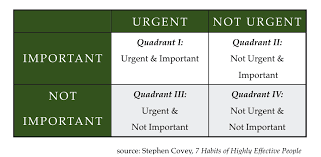Wellbeing experiment #3 - The procrastination cure
Starting the year by clearing some 'big task' clutter

Welcome to week 3 of the Wellbeing Experiments.
If there’s one thing I need to do to get this year off on the right foot, it’s taking care of some longstanding and important tasks that I have been majorly procrastinating on.
These are tasks I have been finding excuses not to do for many, many months, and in at least two cases for several years.
I tend to default to the things I enjoy, like reading and writing Substack posts and doing jigsaw puzzles, and avoid what I don’t enjoy, like taking care of household tasks and financial matters.
As a prime example, I marvel at how often my younger brother changes cellphone plans, whereas I’ve needed to change mine for a couple of years now because my current provider is not good on either service or cost. Others keep chiding me for not changing it when I can’t get reception, and I reply “I know, I know. I need to change it.” And then I don’t.
Time to get all of these longstanding tasks taken care of, by learning a new approach for dealing with procrastination and ticking things off that ol’ ‘To Do’ list.
This week’s approach
We’re going to use some recommendations made by Dr. Richard Wiseman (below), Professor in the Public Understanding of Psychology at the University of Hertfordshire, in his book Rip It Up: The radically new approach to changing your life, combined with some concrete activities I’ve learned and used in the past.
His recommendations are based on research in psychology and behavior, his own and others’, and can be used to change any category of behavior, including habits around overeating, smoking, and drinking,
We’ll be using them in one of the areas he specifically covers in the book — overcoming procrastination and supercharging one’s motivation, self-control, and willpower.
In case it’s of interest, he also has chapters on how to be happy, attraction and relationships, mental health, persuasion, and creating a new you.
Purported benefits
Dr. Wiseman includes this quote by renowned psychologist and educator William James — the cool dude below — in his chapter on willpower:
Nothing is so fatiguing as the eternal hanging on of an uncompleted task.
That pretty much sums it up. Tasks that are sitting on our ‘To Do’ lists and never get attended to and completed are a form of psychic clutter.
They are always there niggling away at us in our unconscious, demanding to receive attention. We expend precious intellectual and emotional reserves suppressing unwelcome thoughts and feelings about what we know we should be accomplishing but aren’t.
By doing this we are also reducing our belief in ourselves as someone who has agency and can get things done in the world, someone who can accomplish positive and meaningful things.
It thus has a negative impact on our sense of identity, on our view of ourselves as a worthwhile human being and as someone who is as deserving of the good things in life as others.
We are succumbing to our negative impulses, in many cases a fear of success or a fear of failure. It doesn’t matter which it is, or if it’s simply an inability to motivate ourselves to act. We are being held back in our lives by our inability to attack and vanquish those tasks that we have valued enough to put on our ‘To Do’ list or to allot a parking space in our psyche.

Not only does this affect our identity and self-esteem, but there are often real world costs — things we lose, things we are forced to give up, things we fail to secure for ourselves.
There can also be significant consequences in terms of delaying or even sacrificing career, financial, relationship, reputational, and life rewards that we desire, simply because we fail to do what we know needs to be done to attain them.
Overcoming procrastination and getting important things done can therefore bring us some pretty impressive benefits:
an uncluttered brain with greater capacity for responding expeditiously and wholeheartedly to the opportunities and challenges life throws at us
elimination of the fear, anxiety, and other negative habits and self-talk behind the procrastination
an inclination and even an ingrained habit of taking care of what needs to be taken care of and doing so when it needs to happen (rather than months or years later)
satisfaction, pride, confidence, and enhanced self-esteem in one’s actions and accomplishments that carries over into other areas of one’s life
an identity and self-image as someone who can get things done and do positive, life-affirming things for themselves, others, and the world
concrete benefits in terms of one’s career, relationships, reputation, financial status, health and wellbeing, and overall quality of life.
What to do
Dr. Wiseman outlines some key ways to overcome procrastination, which I have combined with some concrete activities I’ve learned and used in the past to produce a ten-step process.
We’ll test it out and see how well it works this coming week.
Step 1: Make a list or inventory of what needs to be done
You need to get all of those tasks floating around in your subconscious asking for attention out of your head and onto some sort of list.
Round up them ornery suckers from whatever part of your mind they’ve wandered off to and wrangle them into the ‘You’ll be A-OK once I take care of you’ Corral.
The idea is to collect all of them in the same place, so you can see exactly what tasks you’ve got and what kind of time, attention, and outlay of funds each will require.
Some will need a lot of attention to complete them, some just a little. Some will be more urgent, some just ‘good-to-have’ but not essential. Some will require a significant commitment of time, some will be quick and easy to cross off your list. Some won’t cost anything, some may require a substantial outlay or investment.
The form of the list is up to you, but I recommend that it be one that you enjoy interacting with. I used to keep a list with different colored felt tip pens for each category, which was visually satisfying and fun. But now I have so many items and categories that I keep a Word list that I can update every time a new task crops up or gets completed. I get a great deal of satisfaction in moving items into a ‘Completed’ list at the bottom, which is good to look at when I need confirmation that something’s been done or when I need motivation to keep on trucking.
Some might prefer to use an online software for this purpose, like Trello, or a spreadsheet where they can easily move things around and add different columns of information (e.g., location, others involved, estimated time, completion date, etc.).
Whatever you choose, keep in mind that it will be changing all the time, so it needs to be flexible and easy to update.
I find that it’s easier to round up all the tasks and assess them if I put them into categories or ‘sub-corrals.’ The ones I typically use are as follows:
Work/Business
Health & wellbeing
Pet
Social & leisure
Home
Finances
General admin
When I have a big project, I tend to have a separate category for that. For example, I have a category for each of my substacks to stay on top of what needs to be done.
The key is to set it up to work for your life and your needs. And keep it interesting and fun. You don’t want a boring makes-you-yawn list, but rather a list that motivates and gratifies you, one that displays and celebrates that you are accomplishing things.
Step 2: Set priorities
Once you’ve got your list or inventory done, you need to go through and assign every single task a rating to indicate its level of priority.
There’s not one right way to do this. For instance, here’s one (which I don’t recommend unless you’re doing this on a daily basis):
Here’s another approach touted by Steven Covey in his bestseller The 7 Habits of Highly Effective People, rating tasks by two criteria — importance and urgency:
I prefer to use a simple system — high, medium, low — based on these two questions:
If I complete this, how much better will my life be?
To complete this, how much time and effort will be required?
High priority = My life would be so much better if I did this, and worth the time and effort involved
Medium priority = My life would be better, but it’s not a huge priority and/or requires a significant investment in time, effort, or cash
Low priority = I’d like to do this at some point, but it’s not a priority and can wait
Use whatever makes sense for you. If you’re like me, you have an innate and intuitive sense of what your priorities should be. But some people prefer or enjoy using more sophisticated rating systems, and that’s fine too as long as it isn’t an impediment or distraction from moving forward to the succeeding steps.
In other words, don’t get bogged down in getting the ratings right. If you have your top three or five priorities, that’s all you need to proceed.
Step 3: Identify the steps for each task
This is remarkably important, perhaps the most important thing to do.
One of the reasons we procrastinate is that a task seems too big or too hard. It’s downright daunting.
We give up before we even attempt it, or if we do proceed with it, we throw in the towel the first moment we encounter any challenge that validates our view that this is just too big or too hard for us. It becomes a self-fulfilling prophecy, because just about every task poses some sort of challenge.
The fact of the matter is that we’re approaching the task the wrong way. Every task is actually a series of steps, one following upon the other, and those steps in and of themselves are not all that daunting.
The trick is to break down each task into its smallest constituent steps, until you reach the point where you look at the steps involved and think, “What’s the big deal? I can do all of these.”
If you don’t know how to do something, then one of your steps should be “Find someone who knows how to do this and ask them to show me or explain it to me.” People love to give advice and show off their expertise. (You just have to approach them at the right time, with appreciation and without expectation. Keep looking until you find someone who can help you.)
For example, my steps to find a new cellphone carrier might look like this:
Get a copy of my monthly billing for comparison.
Read through it to understand what services I’m receiving and what I’m paying for them.
Do an online search for cellphone companies.
For each company, research its consumer ratings and read comments.
Eliminate companies with bad ratings and comments.
Research the remaining companies for coverage in my area…
You get the picture. When I look at these steps, I think “I can do this. It’s not hard, and it shouldn’t take that much time.”
Do this for all of the high priority items you want to tackle this week.
Step 4: Plan for setbacks and challenges
There are more likely than not going to be steps where you come up against a grumpy call center employee or an uncooperative search engine or some other sort of impediment.
To prevent yourself from giving up, it can help to identify options for dealing with any impediments you anticipate might pop up.
For example, if I can’t find what I want on google, whose search function doesn’t always show me what I’m looking for, I can switch to another search engine, or I can use “before:2023” to get results from when its algorithm was less commercial.
Some people like to do flowcharts, which allows them to anticipate and plan what they will do if they get different results at certain steps. For example:
Dr. Wiseman recommends identifying ‘triggers’ and the new behavior pattern you will use instead of the old one. For example:
Trigger: I encounter someone who says they can’t help me
Old behavior: Take it personally or assume there’s no help available, and give up
New behavior: Politely ask them, “Can you please tell me who you would recommend that I contact or who you believe could help me resolve this?”
The idea with identifying options and planning for triggers is to prevent your critical mind from defaulting into negative self-talk and encouraging you to abandon the task. You want to stay the course and not be deflected.
Step 5: Hang pledge cards in prominent locations
Dr. Wiseman also recommends supporting positive self-talk and motivating one’s self by writing pledge cards and hanging them where you will often encounter them.
He recommends on your desk, the fridge door, or the bathroom mirror.
On the pledge card write your goal.
For example, for me that would be:
I pledge to find a new cellphone carrier that gives me great coverage at the best price.We know from research that this has to be stated in a positive and not a negative form to influence your unconscious motivation and drive in the right direction:
Wrong way: I pledge to not be fat and out of shape.Right way: I pledge to get fit and reach size 10.Change the card every time you achieve a goal and move on to a new task.
Step 6: Set aside a specific time
We know from research that willpower wanes over the course of the day as we get more worn out.
It also weakens when we are under the influence of something — alcohol, drugs, a post-meal stupor, an overbearing personality, someone we can’t say ‘no’ to, etc.
Our willpower is likely to be better earlier in the day when we’re fresh and alert.
It’s also likely to be better when we have protected time and space that enables us to focus unimpeded on the task.
Ideally, we would book time into our calendar devoted to this specific task, and work on it in an environment where we have control over noise and can minimize other distractions.
Step 7: Sit up straight and tense your muscles
People who sit up straight have been found to persevere twice as long at a challenging task than those who are slouching.
Research has also shown that highly motivated people tense their muscles before they spring into action, and doing it in the opposite direction also works — by tensing a muscle you can increase motivation, willpower, and self-control.
It’s as if you’re signaling to your body, “Get ready, because it’s time for action!”
Dr. Wiseman recommends making a fist, contracting a bicep, gripping a pen, or pressing the thumb and index finger together.
He also recommends placing the center of your computer monitor above your eyeline to encourage you to maintain good posture.
Step 8: Pull the ‘task’ toward you and hug or kiss it
This may seem weird, but research has suggested that pushing something away from you signals to your brain that you don’t like it, whereas pulling it towards you signals that you like it and welcome it.
Even better, he believes, is giving it a hug or kiss to show that you not only welcome it but are enthusiastic about it.
This is a way of helping your mind to reframe that task as something positive and enriching that you are eager to accomplish.

Step 9: Act ‘as if’
An exercise I have used to great effect comes from neuro-linguistic programming (NLP).
Identify someone you know who would kick ass with this task, and act ‘as if’ you’re them.
It could be someone you know personally, or it could be someone you admire in public life.
Take on their confidence, drive, and other qualities that you know would take them to the finish line with this project and make it an unqualified success.
I once acted ‘as if’ I was Erin Brokovich when I had to negotiate with a difficult person around salary and benefits, and it worked like a charm.
Look at that stance! Would you mess with her?!
Step 10: Take it one step at a time
Rather than rushing to complete it, give each step your complete and undivided attention and give it your all. See it as a learning and growth experience — a mountain you are learning to climb and conquer.
As the Chinese proverb says, “A journey of a thousand miles begins with a single step.”
And every journey is about putting one foot in front of the other. Leaping ahead, jumping, and other stunts to get there faster can actually injure you and delay or cut short your journey.
Be mindful and enjoy the trip. Meet and get to know new people along the way. Learn, adapt, and grow as a person. And have fun!

Bonus recommendation: If called for at any point along the way, ‘Do Something Different’
Dr. Wiseman recommends a technique called DSD — Do Something Different — if you find yourself in a mental quagmire or feeling stuck. This was developed by two colleagues, Ben Fletcher and Karen Pine.
The idea is to do something to escape from your normal routine and expand your horizons. Take a new route to work, sample a different cuisine, watch a film or TV show you would never normally watch, try out a new sport, visit an unfamiliar city — literally anything that will jolt you into seeing and experiencing the world with new eyes and heightened senses.
By doing this, you can return to the task with a new frame of mind and a different perspective. The challenges are likely to seem less significant or easier to overcome as you see that there are many paths to the same goal, and you don’t have to stick to the same strategies you always use to get where you want to go.
You can take a different path to scale that mountain!

MY FINAL ADVICE: Reframe, reframe, reframe! That’s the key to overcoming the negative self-talk that accompanies procrastination. Acting ‘as if’ you’re a doer and completer — perhaps by pretending you’re someone you admire — and then plunging in might turn out to be a game-changer for you.
See you next Monday, when I’ll check back in to share my results for the week. I’m going to give this task two weeks to work on, because it’s a biggie. So I won’t be sending out the next challenge until the following Monday.
Enjoy the feeling of accomplishment and spaciousness you feel once you get some items crossed off your ‘To Do’ list, if you decide to try this out and it ends up working well for you. And have a great week!
Resources
Rip It Up: The radically new approach to changing your life. Richard Wiseman. Pan Books. 2012.











Some very helpful ideas here, thanks. I have *excellent* procrastination skills and being retired with [theoretically] more time to get things done has not really helped. . . that 'to do' list for drinking coffee looks familiar!
I was going to read and reply last night but I didn’t get to it. 🙂
Great ideas all, especially writing things down. I always tell people who want to lose weight that they need to carry a pad around and every time something goes into their mouth to write it down. They’re always amazed at what they’re actually consuming. Let me know how that cell phone provider change goes.